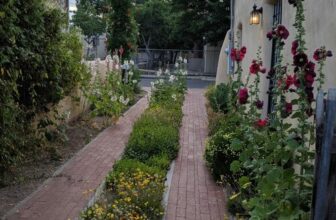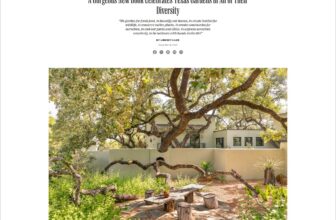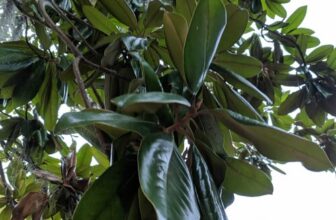
In his new book called “Close to Home: The Wonder of Nature Just Outside Your Door” (affilate link) conservation biologist Thor Hanson encourages us to retrain our eyes and connect more intimately—and also to take actions that can enhance the biodiversity of the place we call home.
Thor Hanson is a conservation biologist whose work has taken him around the globe to a wide diversity of habitats. He is a Guggenheim Fellow and a recipient of the John Burroughs Medal for distinguished natural history writing, and the author of multiple books—the latest of which is “Close to Home.”
Plus: Comment in the box near the bottom of the page for a chance to win a copy of “Close to Home.”
Read along as you listen to the July 28, 2025 edition of my public-radio show and podcast using the player below. You can subscribe to all future editions on Apple Podcasts (iTunes) or Spotify (and browse my archive of podcasts here).
‘close to home’ with thor hanson
Download file | Play in new window | |
Subscribe: Apple Podcasts | Spotify
Margaret Roach: Hello out there in the State of Washington, the other side of the country. I’ve been enjoying reading the book very much; a good escape from the news, the big headlines, and sort of talking about looking at the little things, which is wonderful. The little things that are really the bigger things [laughter].
Thor Hanson: Yes. And an escape that is always right next to us, close to home, right outside the door.
Margaret: Yes. So you say in the introduction that the heart of backyard biology has three themes, three guideposts, and then in the book, you remind us of them a number of times. So tell us about those three guideposts of backyard biology.
Thor: Sure. Well, I developed these to organize the book around these fundamental themes, observation being the first one: what’s out there in the yard? So retraining our eyes to try and see these things that we overlook as the background of our daily lives. We walk right past these things all the time that might be buzzing around in the shrubbery, or rustling through the grass, and we don’t take the time to pause and look at them. So that’s the first one: is observation.
And then the second question that I really wanted to ask was not just what’s out there, but what’s it doing? And when we give ourselves, again, more time in these places, we can observe behaviors that are many times very surprising and revealing.
And then the third theme of the book that I wanted to explore was: how can we help? What are the simple things that we can do to improve the habitat in our yards or neighborhoods, and really boost the biodiversity on almost any patch of land?
Margaret: At one point in the book, you confessed that despite your expertise and training, there was one area of your home property in Washington State where you live that you say you, “had been looking at daily for years apparently without seeing a thing.” And I think that’s really true of all of us.
Thor: Absolutely. Absolutely. We tend to focus on certain aspects of any scene that we’re looking at. The brain will identify certain things, and then kind of fill in the rest with images and things from memory, and colors and shapes and so on, so that we can walk through the world without being constantly distracted. But in a sense, what I’m asking us all to do is to allow ourselves to be distracted, to allow our keen powers of observations to really see what’s happening all around us. And when you do that, I think even for someone who is a trained biologist as I am, you’re astounded by all that’s going on in these tiny and familiar places.
Margaret: I know as a gardener, it’s easy to get caught up: “Oh, the next chore; oh, I have to go out and blah, blah, blah, mow the whatever, weed the whatever, edge the something or other, water the blah blah.” [Laughter.] And you can get fixated on that, your mission so to speak, and see nothing else. Do you know what I mean, be oblivious to everything else, and that’s a shame. But I do it; we do it. And I have to remind myself there are the other times when I need to just slow down.
Thor: I tried to come up with ways to sort of trick myself into doing so, and one of them was I decided, alright, well I’m going to crawl through the yard-
Margaret: Oh, I loved that. That was my-
Thor: …on my knees [laughter].
Margaret: …favorite part of the book. You changed your perspective. You said it was just like, wow. [Above, a potter wasp Thor spied while crawling on the ground in his yard.]
Thor: Yeah, you get down and suddenly it seems like the yard is much larger because you’re moving so slowly. But also with your perspective down at ground level, all of these tiny little things that you wouldn’t see from the lofty heights of your normal position come into view. They might be tiny fungi, little mushrooms the size of matchsticks, or insects and spiderwebs in amongst the grasses that you’ve never noticed before. All of these things happening down there at that micro-scale, and it’s not just what you see, but it involves all the senses.
One of the most striking things to me when I did that, getting down on all fours, was I came face to face with the smell left behind by a fox. And I knew that there were foxes passing through the yard. I had heard them, occasionally seen them and so forth. And even on occasion, I smelled that sort of musky smell that I associated with a fox. But to hit it at fox level was overpowering, this pugent signal, this aroma that they had put out to mark their territory. And I couldn’t, of course, understand all the nuances of what the fox was trying to tell other foxes, but I certainly understood the basic text. It was a very powerful signal.

But I thankfully got down on my knees and crawled around and it was—I don’t know if it was hundreds or thousands or millions or however many it was—alive. It was like all these little tiny beads of caviar. It was springtails, all together [below], and they were just pulsing. They were just moving. It was alive. And if I hadn’t seen it then, and if I hadn’t crawled around right then, it went away pretty quickly. But again, it looked like a big stain over about 15 feet of this area. And then it went away because they were on the way somewhere [laughter].

Margaret: No!
Thor: You can’t do it. And so you really have to give yourself and force yourself to make it happen in the moment.
Margaret: Yeah. And we don’t have to be a scientist to make these observations. And you point that out in the book, too, that we just have to use our eyes and slow down and look carefully, tune in. We don’t have to have the training. And in fact, even laypeople, let’s say, like myself, we can make observations that are valuable, that are important to ourselves, and also we can share them and they can be valuable.

And there are so many scientists in the world, yes, but there’s a lot more data than those scientists could ever gather on their own. And so time and again, they are reaching out and asking all of us to contribute our observations on answering questions on everything from climate change to amphibian populations, to the timing of spring events, to almost anything you can think of.
There’s a wonderful project where they wanted to get samples of soil from across the country, and it was these biochemists looking at this stuff because they were interested in the compounds that soil fungi were making, most of which had never been described. And people were so excited to do this. They were just overwhelmed with samples. But they processed this stuff and they basically rebuilt the library of compounds that people at the National Institutes of Health use to access when they’re looking for new drugs and new cures for disease and so forth.
One single sample from a backyard in Alaska has already yielded a promising new compound that is being investigated as a cure for breast cancer, as well as a compound that eliminates the odors of almost anything you throw at it. So that has been licensed and will soon probably show up in your kitty litter.
Margaret: [Laughter.] Oh my. Early in the book, I think you cite a few well-known names who have spoken about this looking closer. And so John Burroughs—I mentioned that you won the John Burroughs Medal for your writing in the past—he famously said, “Look underfoot.” And I always think about that, and I think he also said, “Every place is the center of the world.” It doesn’t have to be anywhere; we don’t have to go to Yellowstone or whatever, or the Grand Canyon or some famous place. Right here is fine.
And you mentioned one of Darwin’s discoveries that was in a very familiar spot, not some fancy place, right? His discovery, I think, about the seed bank?

So the vast majority of his research and his discoveries took place really in his backyard and neighborhood. And his ideas about seed banks began to take shape simply from walking along what he called the Sand Walk through his yard [above], and seeing a plant come up in a place that had been recently disturbed that he hadn’t seen for years, and realizing that the seeds must still be there in the soil. And that led to a whole bunch of experiments.
He saw similar things on walks through the countryside where they were doing road work, and they’d expose a new bank of soil and suddenly there’d be all these plants coming up that weren’t anywhere nearby. And he realized that these seeds could remain in the soil for years or even decades. And that was an important discovery that informed all sorts of management of land, and agriculture, and how we understand the nature of seed banks and botany in the wild.
Margaret: I didn’t know that that was one of his accomplishments, so that was fascinating. And so a little bit about some of the other kind of “why look more closely” and what we can infer and actions that we can take. Because if we know more about what’s going on, not only will be fascinated and so forth, but maybe we can help, or at least not hurt.
And you give examples. I think you use one example for instance of ground-nesting bees and the particular soil conditions that they require. And that if we don’t have any of that kind of, I guess open and I would say friable—I don’t know what the word is—soil in our landscape, they don’t have as good an opportunity to make use of it, right? I mean things like that we can learn and then maybe make a space or stop doing some behavior that harms or prevents. And you give other examples, bird’s nests and so forth. So let’s talk a little bit about some of those takeaways I think.
Thor: Oh sure. This gets down to something that in a sense came up for me at a recent talk I was giving. Someone asked afterwards in the Q&A, “Well, does all this do any good, talking about nature and getting out, and are you convincing anyone? Are you changing anything in the real world?” And I told him, I said, “One thing we know of is that you can’t care about things you don’t know about.”
And so when we do slow down and start observing these things close to home or broader scale, when we start learning about these things, it engages our empathy and it opens the door to helping. And when we look at that in a backyard or a neighborhood park or someplace close to home, there are all sorts of things we can do in changing the management of these areas that boost biodiversity.
You mentioned bees. There are all sorts of ways to encourage the nesting habitat that bees require, because they’re not just there in your yard during the few weeks you see them on the flowers in the summertime. They’re there all year long, surviving in the soil or in holes in wood, or the ends of twigs and things. And so if we provide that nesting habitat we can encourage them year-round.
The same goes for things like birds that might require a particular kind of nest or that might require a particular kind of food. One of the great things that we can do that is hardly takes any effort at all has to do with light pollution.
That is that after hours, we’re used to the idea of seeing moths circling a porch light or moths at a bright window landing there. And it’s nice to see the moths. But keep in mind that every time you see that happening, you are witnessing an organism doing something that it shouldn’t be doing, in that those moths are disoriented by the light and they’re wasting valuable time in their brief adult lives that they would otherwise be using for finding a mate and contributing to the next generation.
And you might think, well, I’m not that crazy about moths anyway. Why bother? Well, if you really want birds in your yard, you’re going to want every moth you can get. Because it turns out that songbirds use moth caterpillars as one of the main food sources for their chicks. Thousands and thousands of them have to be gathered, not over huge areas, but really with just within just a few hundred feet of the nest.
And so all of these small things we can do, you turn out the light, you draw the shades on the window, you change out the outdoor lights to motion-sensitive rather than on all the time. All of those things are simple, and they really do boost biodiversity.
Margaret: Yeah. In the book you mentioned nests and so forth as well, and bird’s nests. For me, really, I always feel like it’s such an intense sense of privilege that comes with witnessing any of these creatures going about their lives. But certain of them—I mean, like discovering where a particular species of bird nests and how it constructs the nests. And of course, I’m just completely dumbstruck by the fact that members of the same species seem to know the recipe and the architectural plans for that species nest [laughter] and where to place it exactly. And I mean it’s amazing, it’s amazing. You can almost, even with an empty nest, you can kind of figure out whose it is or get close, at any rate.
You talked about a bird that I love very much, the brown creeper, and its nest, and how you’ve welcomed more of them or attempted to invite more of them to be able to nest in your yard by making them at home. How did you do that?
Thor: Well, there’s this concept in ecology that we call the limiting factor. And the limiting factor is the resource that is in shortest supply in any given habitat. So what is preventing the population of organisms from growing or thriving is usually the things that they can’t get enough of. And in our yard, I often see brown creepers in the wintertime, and I love the song that they sing. Even on a day in February, they’re already practicing their spring moves, and sing in their wonderful delicate little voices.
But we would never have them during the breeding season. They would just disappear. They would visit in the winter, and then move on. And I realized that the reason for that is that we didn’t have the habitat for them to build a nest. They are looking for a particular place. They look at old trees that are dead or dying and have bark that is beginning to peel off from the bottom. So there’s a little cavity underneath that peeling bark, and that’s where creepers nest, that’s what they look for in any forest.
And since the woods behind our house are relatively young and we don’t have those sorts of trees, they would have to move on. They wouldn’t spend the breeding season here. Well, it turns out that we heat with firewood, and I spend a lot of time at the chopping block. And if you do that, you end up with a lot of bark that peels off of some these rounds of wood. And I thought, well, you know what? Maybe I could provide that habitat and relieve that limiting factor for these creepers in the yard. So I went out without high hopes, but I thought it’s worth a shot. And I put up some strips of bark in the right sort of position on some tree trunks.
And at first there was nothing and nothing. And then I’d almost given up hope. But late in one springtime, I peered beneath one of those strips of bark and creepers had nested. And now they are resident here all through the nesting season. I am embarrassed to say how many of these things I put up, but it’s got to be more than 20 now. I’m very fond of creepers.
Margaret: Me, too. Me, too.
Thor: This year alone, three of them are filled with nests, and isn’t that marvelous? And that’s again, an example of, it’s a small thing, this little thing. But here we have improved the habitat for this great species right here at home and we can see them now.
Margaret: I’ve again been privileged to watch a goldfinch using her beak, like a small circling motion, to wrap bits of spiderweb from on the outside of my windows that I hadn’t dusted or something [laughter]. But she’s collecting sort of glue, adhesive, for her nest. And I’ve seen great crested flycatchers searching for shed snake skins in my stone wall and then flying off with one in its beak to make its nest high up in a tree.
And this is just miraculous stuff when you realize that you have some of the raw materials, or as you did, you’re providing more of the raw materials once you discovered what those were.
I feel like nighttime… you were talking about turning out the lights and so forth. We don’t see so well in the dark. And a lot of the creatures of the night do; they have special kinds of eyesight adaptations and so forth and structures in their eyes. But I feel like by going out at night, and for me it was going mothing, going to moth nights and so forth, I met a lot of other residents of the area [laughter], a lot of other of organisms that live here that don’t come out during the day. Also, do you explore at night, too, in your place? I mean, have you gotten to know the nightlife, the night shift sort of, of creatures as well?

And so getting out there, you realize you’re missing half the show. There are all of these moths and there are the wonderful owls that are active at night. You’re going to see the bats, you’re going to see insects of all kinds that you haven’t observed during the daytime.
And there are a couple of tricks that I think are really helpful for getting out there at night. One is what you can do with a flashlight. And if you take a flashlight, a typical headlamp or a handheld, whatever you have lying around, there’s something magical that happens in that it reduces the world that you see to that one beam. And it helps you focus on a tiny amount of habitat, a tiny amount of space, where if you go out in the day, you just see everything, and it can be kind of overwhelming to try to focus on something small. Well, the flashlight does it for you. And so that allows you to see things in a very different way.
And then the other thing you can do, is if flashlight has the feature to switch it to the red setting, and it’s very dim at first, but your eyes will adjust, and you will be able to see in that red light. And that gives you a real advantage. You get to see more, but you also are seeing in a way that is less disturbing to a lot of creatures out there.
So if you have frogs in your neighborhood, for example, and you’ve been trying to find them, you can hear them singing or what have you, well, go out at night with the red on your flashlight and those frogs don’t see in that spectrum. So you can come right up next to them, right up close, and they see you as just part of the darkness. They don’t see that red lamp at all. So you can observe them without disturbing them. And that’s quite magical. And the same is true of many, many insects out there as well that don’t see in the red spectrum. So you can sneak right up on them and get a wonderful view at night without disturbing them in the slightest.
Margaret: Well, Thor Hanson, I’ve really enjoyed “Close to Home,” your new book, and I hope I’ll speak to you again. Thank you so much.
Thor: Oh, thank you. I look forward to another conversation. It’s been a delight.
enter to win a copy of ‘close to home’
I’LL BUY A COPY of Thor Hanson’s “Close to Home: The Wonder of Nature Just Outside Your Door,” for one lucky reader. All you have to do to enter is answer this question in the comments box below:
Any discoveries of some creature or goings-on in nature in your own backyard that caught your attention? Do tell, and tell us where you garden.
No answer, or feeling shy? Just say something like “count me in” and I will, but a reply is even better. I’ll pick a random winner after entries close at midnight Tuesday, Aug. 5, 2025. Good luck to all.
(Disclosure: As an Amazon Associate I earn from qualifying purchases.)
prefer the podcast version of the show?







